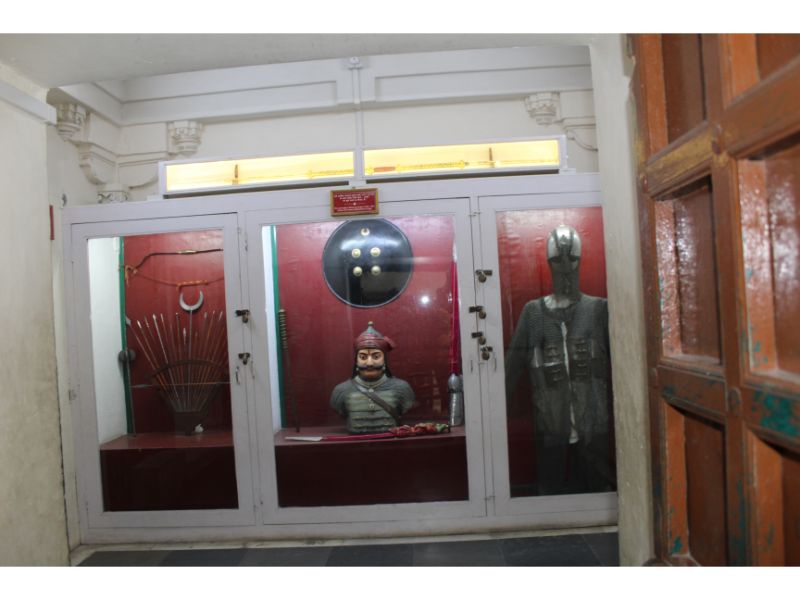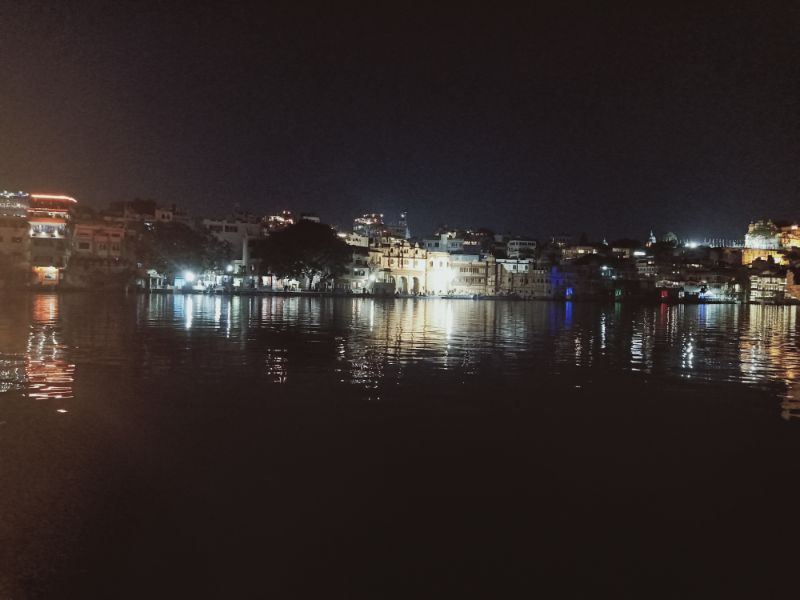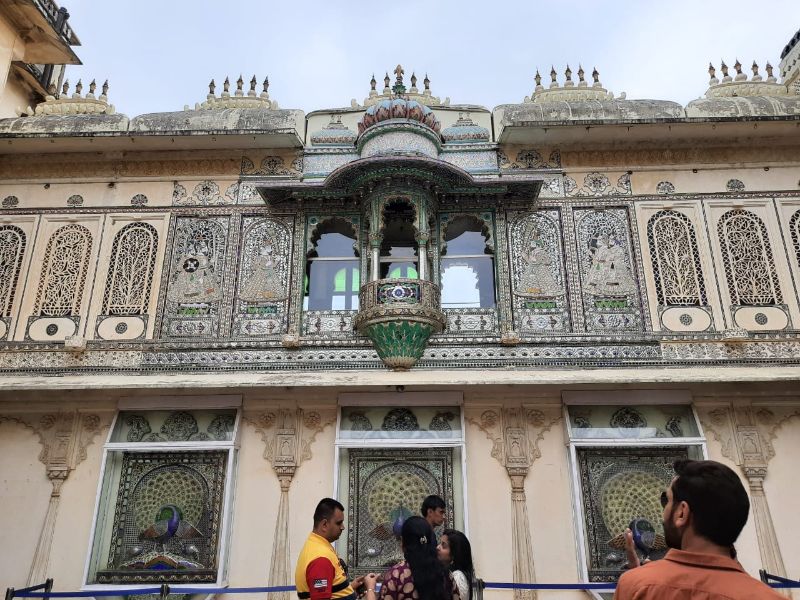City Palace of Udaipur-royal residence with a rich history & impressive architecture. Though Udaipur’s charm did not attract me as much as other cities, I still wished to explore royalty’s subtle taste.

I took a ticket at the cost of 300 INR per individual. Since the city palace is still under Udaipur’s King, an Indian guest & foreign guest’s expense is the same, including the camera charges. Looking at the board while buying tickets, I saw the light and sound show conducted at 6 pm at the cost of 500 INR. In any case, due to COVID, it has been temporarily suspended. However, the boat ride on Pichola Lake was still accessible at a charge depending on the Pax & boat chosen. I bought my tickets & walked up to the entrance of the palace.

While I stood in front of the main gate, I reviewed a line composed by Shobana Baset-“The cities having forts are privileged for these are rare gems, amidst sprawling beads of malls.” And it’s right to an extent since Udaipur Palace was built over 400 years by 22 generations of Sisodia Rajputs. The construction started in 1553 by Maharana Udai Singh II of the Sisodia Rajput family when he moved his capital from Chittor to Udaipur’s newly discovered city. The City Palace in Udaipur was built ostentatiously and is considered the second-largest palace in India. The primary is, of course, the Mysore Palace. It was built on a hill, combining the Rajasthani and Mughal architectural styles, giving a panoramic view of the city and its surroundings.

The gateways in Udaipur are called Pols- several such gateways provide access to the royal residence complex. The palace’s fundamental passage from the city is through the ‘Badi Pol’, driving to Tripolia Pol’, a triple-arched entryway built in 1725. Close to the Tripolia Pol’, cannons are kept that were brought from Kumbhalgarh fort. The street between this entryway and the royal residence is lined with shops and stands claimed by experts, bookbinders, smaller-than-expected painters and material dealers.

Between these two entryways, eight marble curves or Toranas are raised. Along with this gateway, the Maharanas used to be weighed here with gold and silver, distributed among the local individuals. Further ahead, there’s an arena between the Toran Pol and the facade palace called the Manak Chowk. Here elephant battles were arranged to test their ability before beginning war campaigns.

Behind the gateway of Badi Pol, a massive wall is used for the elephant fight in the early era. Whichever elephant touches the wall first would be considered a frail elephant. Both elephants would drag each other in this fight—a great form of entertainment.

The city palace is still under Mr Arvind Singh Mewar’s rule, the current King of Udaipur, and is claimed to be the 76th custodian of the House of Mewar. The fractional of Udaipur Palace is the King’s home. The fractional has been opened for public tour. In contrast, the rest has been converted into a hotel.

We hired a guide for our tour, costing Rs 500. The visit commenced with the fact that the 1983 James Bond motion picture Octopussy was shot here. This was an unknown reality; besides, we entered the palace, and first, I saw the jewelled statue of Lord Ganesha. Here we had to sanitize our hands, tickets were checked & masks had to be put on.

Advance, we climbed the stairs to reach an open zone where the warrior ensemble of Maharana Pratap was kept, whose add up to weight was 33kg. Damn! that was way too much. The part of the palace we were touring was called the Badi Mahal or Garden Palace. It is situated on a 27 metre (89 ft) high natural rock formation bis-a-bis the rest of the palace. The ground-floor rooms appear on the fourth-floor level because of the tallness contrast to its encompassing buildings.

The uppermost court inside the complex is known as Amar Vilas- it was built in Mughal style as a pleasure pavilion with wonderful hanging gardens with fountains, towers, and terraces. A cusped arcade enclosing a square marble tub to sit and relax. There’s a water pool, which was utilized for the Holi celebration.

A connecting corridor shows miniature works of art from the 18th and 19th centuries. Besides the wall canvases of Jag Mandir (because it showed up in the 18th century), Vishnu of Jagdish sanctuary, the exceptional yard and an elephant battle scene are portrayed.

I sat on one of the marble tubs, tuning in to the royal residence’s history described by the guide. Initially, the Mewar kingdom prospered in Nagda (30 kilometres north of Udaipur). The Mewar Kingdom was set up by Guhil in 568 Advertisement, who became the first Maharana of Mewar. Be that as it may, the capital was moved to Chittor, a peak fortification in the 8th century, and over 800 years, the Sisodias and Choudhary ruled from Chittor fort.

In 1537 Maharana Uday Singh II acquired the Mewar kingdom at Chittor. However, there were signs of losing control of the fortification in wars with the Mughals. Hence, Udai Singh II chose the location close to Lake Pichola for his new kingdom. The area was well-secured by timberlands, lakes and the Aravalli slopes.

I strolled advance ahead from the patios. And took note the royal residences are interlinked through several Chowks or quadrangles with crisscross passages. I figure it was arranged in this design to maintain a strategic distance from shock assaults by enemies.

Settle halt was Bhim Vilas- a display of a collection of smaller-than-expected canvases that portray the real-life stories of Radha-Krishna.

We went to Dilkhusha Mahal -the palace of Joy’ was built in 1620. Another was Krishna Vilas’s similar chamber, which includes a rich collection of scaled-down works of art that depict regal parades, celebrations and recreations of the Maharanas.

The beautiful part of the palace was yet to come to the Mor Chowk as peacocks square is integral to the castle’s inner courts. This chamber’s elaborate design consists of three peacocks (speaking to the three seasons of summer, winter, and storm) displayed in tall help and confronted with coloured glass mosaic, built into successive niches in the wall area or jharokhas.

Two hundred years after the City palace was established, these were built during Maharana Sajjan Singh’s reign. The peacocks have been created with 5000 pieces of glass, which sparkle in green, gold, and blue. The lofts before the Chowk are delineated with scenes of Hindu god Ruler Krishna’s legends.

Whereas the upper level encompasses an anticipating overhang, which is flanked by embeds of coloured glass. In a connecting chamber called the Kanch-ki-Burj, mosaics of mirrors embellish the walls.

The Badi Charur Chowk inside this Chowk could be a littler court for private utilize. Its screen divider has painted and trimmed compositions delineating European men and Indian ladies.

Proceeding assists from the Mor-Chowk, within the Zenana Mahal or women’s quarters, wonderfully planned niches, overhangs, coloured windows, tiled dividers, and floors are seen.

A part of ‘Zenana Mahal’ has been converted into a museum. We also saw Sheesh Mahal- the Palace of Mirrors and Glass, which Maharana Pratap built for his wife, Maharani Ajabde.

Using the interlinked corridors, we moved to the palace of Widow queens. It was less elaborate and effortless, with a kitchen, sleeping area & a seating place for the queen if other queens came to meet. No men were allowed here.

We exited after checking through the Laxmi Vilas chowk-. A craftsmanship exhibition with an unmistakable collection of Mewar depictions placed in the City Palace.

At last, we moved out of the palace and strolled into shops lined inside the post complex. My mother bought a saree made out of banana leaves & one from mulberry extract, which is handmade in the region. I obtained a cloth piece with a block print made of vegetable colour. To be fair, I have been more excellent palaces than Udaipur, but still, it’s one of a kind.

After spending some time, we chose to cover the day’s final destination, Bagore Ki Haveli. Since it was 6.30 already, I needed to witness the captivating Dharohar folk dance performance within a historic haveli’s authentic ambience. It, by and large, begins at 7 pm, but luckily, haveli was closed due to COVID. Hence we drove back to the Hotel. We had our dinner at the hotel rooftop since we had an early start tomorrow.

Tomorrow we are heading to Kumbhalgarh, so I had to wake up early.
How to Reach:
By Air:
The nearest airport is Udaipur airport, 22km away from the centre of the city. From the airport, you can book a cab to the town.
By Rail:
Udaipur railway station is connected with all Rajasthan cities and important cities around the country. Few luxury trains cover Udaipur as a part of many itineraries. You can book cabs, autorickshaws, and other options to reach your required destination from the railway station.
By Road:
Udaipur is well connected by road to major cities. The road network connects Udaipur with six and four-lane highways, making commutation easier. There are frequent buses, public and private, ply from Rajasthan, Delhi, Ahmedabad, and Mumbai.